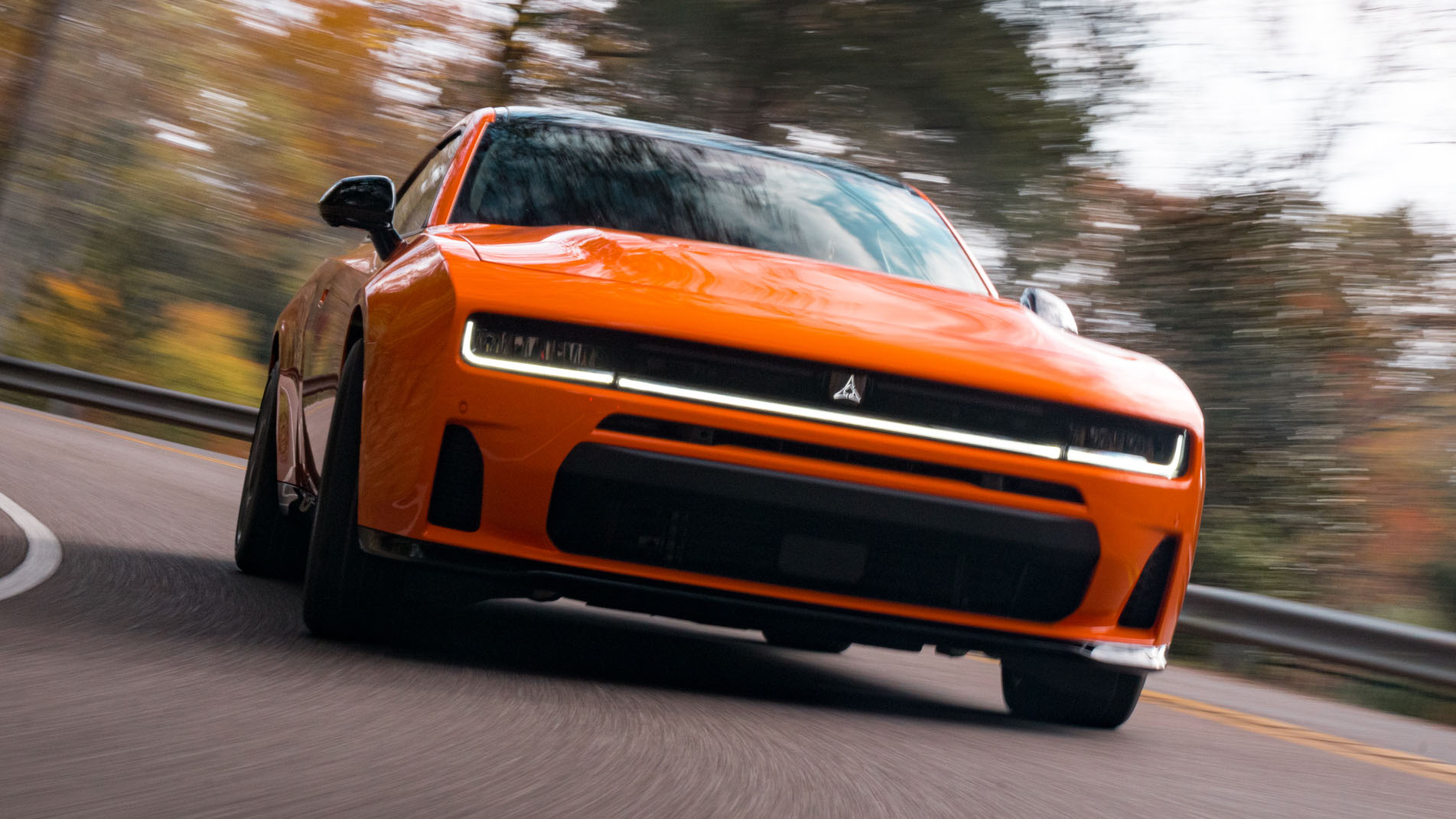
Dodge Charger Sixpack (US) review: time to win the EV cynics back... with a 550hp straight-six
ICE is back with a brand new edition, huh?
Big time. The latest Dodge Charger hit the streets just last year. First, in the form of its headline-grabbing Charger Daytona, the ‘EV muscle car’ that was met with mixed reactions. This time, it’s the Sixpack’s time to shine, the Charger with a twin-turbo inline-six.
Is this because the Charger EV is bad?
Not at all. This was always the plan, but the Daytona was absolutely dealt a lousy hand. Winning over the Dodge devout with an EV was always going to be a tall order, regardless of how superior it would be over the combustion version. Still, we were all eager to see if an EV could be a proper muscle car.
As it turns out, it’s very compelling, with nearly 700hp on tap from the Scat Pack version and a surprisingly smooth, balanced ride that can easily satisfy any impromptu drag race enthusiasts. Plus, it has better handling than we expected, if we’re being frank. Regardless, it was thoroughly trounced in the court of public opinion, with its embarrassing faux exhaust roar not doing it any favors.
All told, the Charger Daytona is better than what the naysayers have led folks to believe, including Dodge, who have seemingly obfuscated the EV-ness of the Daytona to the point where its website hardly mentions it. Between that and Dodge’s current tonal shift toward old-school attitudes, now’s a good time to crack open a Sixpack.
What are the details?
The Dodge Charger Sixpack is fitted with a 3.0-liter twin-turbo inline-six that whips up 550 horsepower and 531lb ft of torque, sent to all four wheels through an eight-speed automatic transmission – at least initially. This is the ‘high output’ version, with a standard output model coming later next year for the more affordable R/T, with the same engine and 420hp.
We say ‘initially’ because the Charger can divide the torque in a few ways to cater to driver needs. Left to its own devices, it’ll maintain an even split, but put it in Sport and the Dodge will shift to a 40/60 split favoring the rear. If the idea of a four-wheel drive muscle car gives you the ick, you can literally shift all power to the rear with a single button press.
It all rides on a multi-link aluminum suspension while Brembo brakes help bring things to a halt.
What are the big differences between the Sixpack and the Daytona?
There are a couple of things worth mentioning up front. The first is that the new Charger was designed from the start to be a ‘multi-energy’ vehicle, so it’s not a matter of shoving batteries in an unused transmission tunnel or anything like that. Making it ICE or BEV wasn’t an afterthought one way or another. To that end, the final products are very close to each other, but naturally, there are inherent differences. The Daytona behaves slightly differently due to the power and torque the EV platform provides and there’s also that unfortunate sound pack that the Sixpack doesn’t need.
Side by side, the Sixpack and Daytona are similar in that they have very aero-friendly lines and a distinct, heritage-inspired look. Up front, the Sixpack’s facia has been opened up to draw in as much air as possible to cool its demanding engine (as well as the brakes), and a hood bump with ‘Sixpack’ stamped on it distinguishes itself from the Daytona’s rather slick pass-through hood channel. Things are fairly similar between that and the rear, where dual exhaust tips now sit, nestled within the rear diffuser.
Inside, you’d be hard-pressed to differentiate one from the other, besides the lack of the BEV’s push-to-pass ‘powershot’ steering wheel button. The cabin is a modern take inspired mostly by the interior of the 1968 Charger. Overall it’s very driver-focused and functional. You’re looking at sporty, fixed-headrest seats, a modern take on the pistol-grip shifter, a 12.3in driver display, and either a 10.25in or 16in digital driver display that can be customized with a few button presses.
Top Gear
Newsletter
Thank you for subscribing to our newsletter. Look out for your regular round-up of news, reviews and offers in your inbox.
Get all the latest news, reviews and exclusives, direct to your inbox.
The other thing to keep in mind is that both are very heavy, which is a factor in how they differ, but also key to their individual behavior, and that neatly brings us to the car’s handling.
So wait, can it actually take a corner?
While the old trope of American muscle cars lacking in the handling department hasn’t been fully upended, the new Charger still handles much better than anticipated. From the start, the steering feels particularly responsive and persists throughout all modes. This works in hand with the Charger’s impressive road feel, as it communicates surfaces well. The 50/50 split keeps the Sixpack steady, and while Sport’s rear bias isn’t a huge shift, it works like a RWD car with big safety handles (in the form of the front axle) to pull you out of trouble.
Dodge’s launch event challenge to the Charger was a run through the infamous ‘Tail of the Dragon’, an 11-mile stretch of mountain road that runs along the Tennessee and North Carolina border. 318 lunch-churning turns in a fat, wide muscle car? Why not.
The Charger felt planted and secure on the treacherous, undulating path, particularly through the shifting weather conditions. Wrenching the hefty Charger through relentless hairpins was far from effortless, but the direct steering added to the feeling of confidence. If anything, its wide-bodied straddling of the road was the most significant hindrance, with the brakes and gearbox tied for second.
For a road like this, we would’ve wanted more bite to better respond to the rapidly shifting situation in front of us, as well as a faster gearbox that here, even in manual, had a hard time keeping pace with split-second responses to conditions. The half-paddles, by the way, have a habit of getting lost amongst the back-of-the-wheel controls they share space with.
But can it daily?
Probably the most low key aspect of the Charger Daytona is its versatility. It’s no crossover or hatchback, but the four-door can fit a family in relative comfort, leaving room to spare in the almost classically long cargo area, almost as if it’s a secret hatchback. Passengers have 103 cu ft of room for themselves while the cargo area provides a substantial 22.7 cu ft. The rears fold down, too, to give a full cargo volume of 37.3 cu ft, which is conveniently the right amount for a full set of wheels should you want to take your dancing shoes to the track. Twinned with the AWD, it’s equipped to be an all-rounder, not just a weekend plaything.
What’s the final takeaway?
The Dodge Charger Sixpack is a surprisingly versatile take on the classic muscle car formula that provides drivers with a great deal of choice. Whereas a contemporary like the Ford Mustang is dead-set on sticking to its trusted formula, the latest Charger is flexible enough to be whatever it’s called on to be, from a stout and steady daily driver to a tail-happy drift toy, and everything in between.
The choices extend from the number of doors to the type of powertrain, too. Two-door Charger Sixpacks start at $54,995 and are ready for delivery now, with four-doors open for orders at an additional $2,000. While we’re at it, the Charger Daytona’s also available for $59,995 and the $49,995 Charger R/T Sixpack is on track to arrive next year.
Featured







